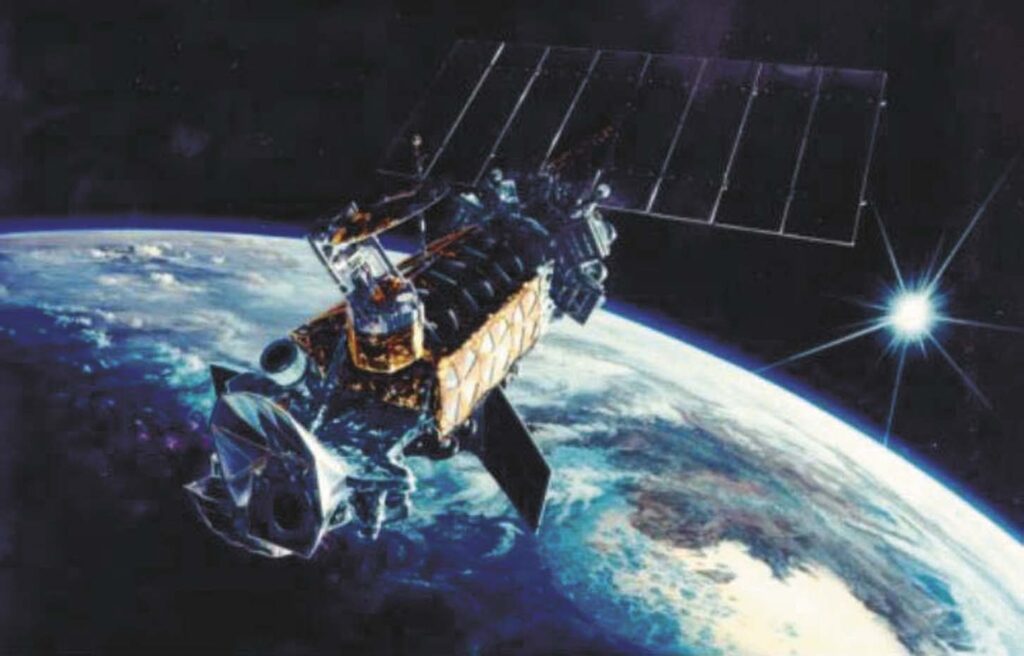Space Force moves closer to replacing aging DMSP weather sats

An artist’s rendition of a DMSP satellite orbiting Earth. (Air Force)
WASHINGTON: With a recent second-stage award to Raytheon Intelligence & Space for prototype demonstration, the Space Force is one step closer to finally being able to replace its few remaining Defense Meteorological Satellite Program (DMSP) weather satellites.
The Dec. 15 Other Transaction Authority (OTA) award to RI&S, worth $67 million, is the second recently granted by Space Systems Command to advance the Electro-Optical Infrared Weather System (EWS) program, which would partially replace the capability provided by the dying DMSPs.
General Atomics Electromagnetic Systems (GA-ES) on Nov. 29 announced its own EWS contract had been “up-scoped from a one year on orbit sensor demonstration to a three-to-five-year prototype spacecraft with residual operational capability.” The company did not disclose the award’s amount.
EWS was launched in 2020 with a set of three OTA contracts for prototype designs, with a total value of $309 million. The third contractor was ASTRA (for Atmospheric & Space Technology Research Associates), which has not yet announced a second stage in its prototype effort. Space Force asked for $162.27 million for the program in fiscal 2022 — a request approved by Congress in the just-passed 2022 National Defense Authorization Act.
DoD’s effort to replace the DMSP polar orbiting constellation, first launched in the 1960s, is a historic tale tale of acquisition woe. The first attempt, launched in 1995, was the ill-fated multi-agency National Polar-orbiting Operational Environmental Satellite System (NPOESS) that collapsed in 2010 following multiple Nunn-McCurdy breaches for its skyrocketing costs. The second effort, called the Defense Weather Satellite System, ran afoul of Congress for management and planning screw-ups and was killed by lawmakers in 2012.
In 2018, the Air Force decided to build two separate constellations to replace DMSP: the Weather System Follow-on Microwave (WSF-M) effort, and the Operationally Responsive Space Number 8 satellite which was to carry an EO/IR sensor suite — the latter of which was killed almost at birth. WSF-M, however, continues to make slow progress, with Space News reporting in May that current Space Force plans are to launch the first satellite, being built by Ball Aerospace, in late 2023.
The original EWS contract announcement said the plan was to “select viable vendor designs for a prototype system build and launch for on-orbit demonstration by 2023.” Raytheon’s press release, however, put down-select in January 2022, with a launch in 2025.
“An on-going EWS competition remains underway to determine which vendor will be asked to move beyond the design phase. Since September, the competing vendors have continued to make great progress and final design reviews are on-track to be conducted late January 2022,” Lt. Col. Joseph Maguadog, materiel leader, for SSC’s EO/IR Weather System program, said in an email. “Once the government has had the opportunity to fully evaluate the competing designs, a single vendor will be selected and announced in Spring 2022, as planned.”
Meanwhile, the Air Force has been investigating alternate weather solutions, with a keen understanding that the WSF-M and EWS birds are not expected to be operational until 2024 and 2026 respectively. Tomorrow.io, a Boston-based startup, in September was awarded a contract worth $19.3 million under the service’s AFVentures Strategic Funding Increase (STRATFI) program, aimed at catalyzing startups and commercial markets of interest to the military. According to a Dec. 20 press release from the company, the funds support development of the firm’s first four radar satellites in a planned constellation of 32 birds.
Tomorrow.io has a unique business model in that it intends to sell what it calls “weather intelligence” — analysis tailored to each client and based on data not just from its satellites but all sorts of other types of sensors, such as cell towers, that has been crunched using artificial intelligence software.